3 EELS
Introduction and species identification
The family Anguillidae, order Anguilliformes, subclass Actinopterygii (ray-finned fish) includes (FishBase 2002) 17 species (two of them with two subspecies): Anguilla anguilla, A. australis, A. bengalensis (spp. A. bengualensis and A. labiata), A. bicolor (spp. A. bicolor and A. pacifica), A. celebensis, A. diffenbachii, A. interioris, A. japonica, A. malgumora, A. marmorata, A. megastoma, A. mossambica, A. nebulosa, A. nigricans, A. obscura, A. reinhardtii and A. rostrata.
Eels are catadromous, migrating from rivers and other inland water bodies to the sea to breed; the young return to the edge of the continental shelf as leptocephali and, having metamorphosed into glass eels, eventually migrate up the rivers. The Japanese eel (A. japonica) spawns in mid Pacific, but the European eel (A. anguilla) and American eel (A. rostrata) migrate to the middle of the Atlantic Ocean to spawn in the Sargasso Sea.
For a long time, the life history of the eel was a mystery, and much of it remains so today. Since eels have different life stages, it is important to name them, as defined1 by EIFAC/ICES (2001).
The stages are defined1 as follows:
? Leptocephalus – the oceanic, pelagic larval eel. For A. rostrata this stage lasts several months.
? Glass eel – small, transparent eel formed by metamorphosis of leptocephali. Metamorphosis occurs at sea, perhaps near the edge of continental shelf. Glass eels are un-pigmented elvers. They enter coastal waters and estuaries and many ascend rivers during the winter and spring.
? Elver – small juvenile eel. The term sometimes used vaguely, but really refers to the first year in continental waters.
? Yellow eel – juvenile eel residing in continental waters. The colour of the specimen is not diagnostic of this life stage. This stage typically lasts several years.
? Silver eel – a sexually maturing eel, migrating to the oceanic spawning area. The colour of the specimen is not diagnostic of this life stage. Transitions to this stage includes changes in body colour, structure and physiology of the swim bladder, and of the eye.
The larvae of the European eels (Anguilla anguilla) travel with the Gulf Stream across the Atlantic and reach Europe after 3 years, at a size of around 45 mm. The glass eels migrate up the rivers, crossing all kinds of natural challenges, sometimes by piling up their bodies in large numbers to reach even the smallest creeks. They can even slide over wet grass and dig through wet sand in order to reach headwaters upstream and ponds. In freshwater they start pigmentation, turning into elvers and feeding on small crustaceans, worms and insects. They may remain in this form for up to 14 years, and reach a length of 60 to 80 cm. They are then called yellow eels because of their golden pigmentation. In July, their instinct drives them back toward the sea, even crossing wet grasslands during the night to reach their rivers (Frost et al. 2000).
1 Note: although these definitions are quite distinct there is often confusion and conflicting data for catches, mostly between glass eels and elvers.
The American eel (Anguilla rostrata) migrates from estuaries and freshwaters along the eastern coast of North and Central America to the Sargasso Sea near Bermuda to spawn and die. Eel larvae develop at sea and return via ocean currents to the continental shelf and enter coastal estuaries as glass eels or elvers. They reside, feed and grow in coastal estuaries and headwaters before returning to the sea to spawn and complete the cycle (Field 1996). Males reach sexual maturation after 6-9 years (150 g), females after 8-12 years (500 g) (Tibbetts 2001).
In Asia, the Japanese eel (Anguilla japonica or unagi in Japanese) spends from 5 to 20 years in freshwater and grows to a size of about 45 cm or longer before reaching sexual maturity. At this time eels descend to the sea toward their spawning grounds. They spawn in the Pacific Ocean to the west of the Mariana Islands (Tzeng et al. 2000). The spawning area of Japanese eels was only discovered in 1991, when it was found to be in the North Equatorial Current, west of the Mariana Islands on a salinity front near 15 degrees N, 140 degrees E, 3 000 kilometres south from the growing habitat in East Asia (Kimura and Sugimoto 1994). After hatching, the transparent leaf-like larvae drift with the Kuroshio Current along the Western Pacific coast up to Japan. They are believed to be pelagic for 5-6 months, before metamorphosing into elvers and beginning their river ascent. At this time they are still totally transparent, have the body shape of an eel and are called glass eels. These glass eels are carried by tides into the estuaries of coastal rivers where they undergo further development to become elvers (up to 1-3 years of age), which by now have adopted the adult form in all respects other than size. The elvers then undertake a more active secondary migration into freshwater, the upper reaches of the rivers where they grow and develop into sexually mature adults before returning to the sea to spawn – at an average of 10-25 years of age.
Short-fin eels (Anguilla australis) have a natural distribution from Tasmania, north through Victoria, and up the east coast to Queensland. The short-fin eel is found only as far north as southeast Queensland. Every year, mature silver eels migrate from the east coast of Australia and New Zealand to the Coral Sea, where it is thought that they spawn at depths of around 300 m. Eels spawn only once in their lifetime, and after spawning it is presumed that the adult eels perish. Once the eggs hatch, ocean currents carry leptocephali back to the continental shelf. At around eighteen months of age they metamorphose into glass eels. The glass eels are carried by tides and currents back to shore and into coastal estuaries, where they undergo further development. Pigmentation occurs and the glass eels metamorphose into elvers. Elvers are an exact copy of the adult eel but are much smaller, ranging from 8-20 cm and 1-3 years of age. The elvers migrate upstream to occupy estuarine and river environments, where they mature into adult eels and apparently live for 15-20 years.
Eel fisheries and eel capture-based aquaculture are distinguished from almost all other fisheries because of the life cycle of the eel - that is extremely migratory (Frost et al. 2000). This report focuses on Anguilla rostrata, A. australis, A. anguilla and A. japonica, which are species that are distributed in specific locations worldwide. Tables 3-6 summarize the characteristics of these species, while Figures 12-19 illustrate their appearance and geographical location.
Anguilla anguilla (Linnaeus, 1758)
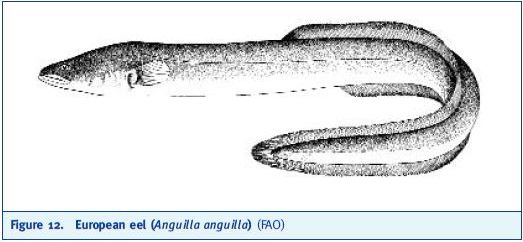
Figure 12. European eel (Anguilla anguilla) (FAO)
Table. 3. Characteristics of the European eel (Anguilla anguilla) (FishBase 2002, modified)
Common name European eel
Size and age Maximum size 133 cm TL (female); maximum female weight can be 6.6 kg, and for a male 2.8 kg; these fish can live for up to 85 years.
Environment Demersal; lives in fresh, brackish and marine waters.
Climate and latitude Temperate: 4-20°C between 70°N-25°N.
Resilience Population doubling time is 4.5-14 years, with low resilience.
Distribution Rivers of North Atlantic, Baltic and Mediterranean Seas. Continuous introductions into Asia and South and Central America, but not reproducing.
Biology and ecology Is an individualist in all its stages. The spawning area is the Western Atlantic (Sargasso Sea). Spawning takes place in late winter and spring (McCleave et al. 1998). After reproduction, the leptocephali move, drifting on the Gulf Stream, during 3 years (Tesch 1977) to the coasts of Europe where they reach 8-9 cm in length before their metamorphosis into glass eels. Then they are transformed into elvers (young eels) before entering the continental coastal zones, where they start pigmentation, turning yellow. They live in freshwater (6-12 years for males and 9-20 years for females) under stones, in the mud or in crevices, feeding on small crustaceans, worms and insects. At 60-80 cm in length, they are sexually mature, turn into the silver form and begin a catadromous migration between October and January (July in Northern Europe) to the sea.
Importance Commercial fisheries and aquaculture; gamefish; show aquarium.
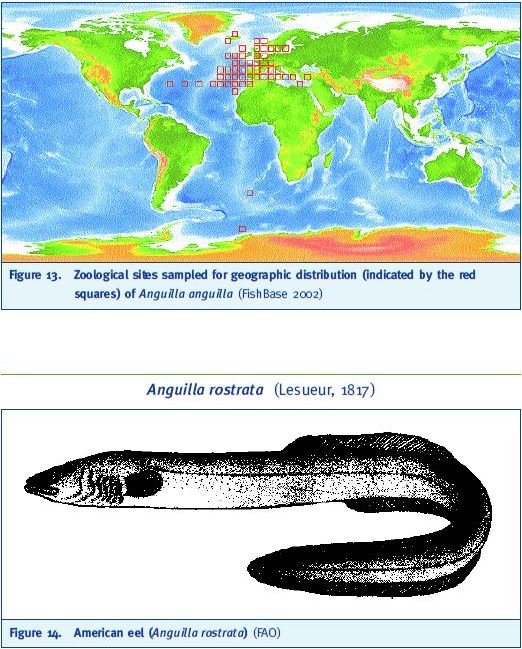
Figure 13. Zoological sites sampled for geographic distribution (indicated by the red squares) of Anguilla anguilla (FishBase 2002)
Anguilla rostrata (Lesueur, 1817)
Figure 14. American eel (Anguilla rostrata) (FAO)
Table 4. Characteristics of the American eel (Anguilla rostrata) (FishBase 2002, modified)
Common name American eel.
Size and age Maximum size of 152 cm TL (male/unsexed) and 120 cm TL (female). Maximum weight is 7.3 kg; these eels can live for up to 43 years.
Environment Demersal species; the female yellow and silver eels prefer freshwaters while males are found almost exclusively in salt or brackish waters with high oxygen content (Fahay 1978).
Climate and latitude Subtropical, between 60°N-9°N; wide range of temperatures (Bigelow and Schroeder 1953) between 4-25°C, with yellow eels having an optimum of 16.7°C (Barila and Stauffler 1980) and silver eels of 17.4°C (Karlsson, Ekbohm and Steinholtz 1984).
Resilience Population doubling time is 1.4-4.4 years with medium resilience.
Distribution East North Atlantic, Atlantic coast of Canada, the USA to Panama and throughout much of the West Indies south to Trinidad.
Biology and ecology Usually occurs in permanent streams with continuous flow. Hides during the day in undercut banks and in deep pools near logs and boulders. Feeds on larvae of Ephemeroptera, Odonata, Plecoptera, Coleoptera, Trichoptera, and Lepidoptera, as well as gastropods, oligochaetes, amphipods, isopods, mysids, and fish from the families Percidae, Cyprinidae, Ictaluridae, Catostomidae and Anguillidae (Lookabaugh and Angermeier 1992). Migrates in autumn to the Sargasso Sea to spawn (Wenner 1978). Adults are caught with eel pots and trot lines. Elvers and glass eels are caught with fine mesh fyke nets and dipnets.
Importance Commercial fisheries and aquaculture; gamefish; show aquarium.
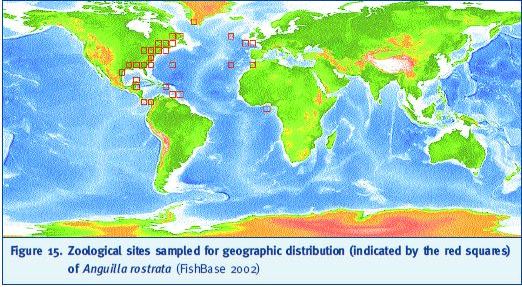
Figure 15. Zoological sites sampled for geographic distribution (indicated by the red squares) of Anguilla rostrata (FishBase 2002)
Anguilla japonica (Temminck and Schlegel, 1847)
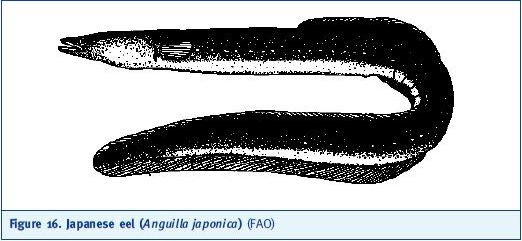
Figure 16. Japanese eel (Anguilla japonica) (FAO)
Table 5. Characteristics of the Japanese eel (Anguilla japonica) (FishBase 2002, modified)
Common name Japanese eel.
Size and age Maximum size of 150 cm TL (male/unsexed) and maximum published weight 0.76 kg. (?) [Approximate maximum size of female eels, according to Usui (1974) is 125 cm and 6 kg.]
Environment Demersal species that lives in fresh, brackish and marine waters.
Climate and latitude Tropical: 4-27°C at 42°N-22°N (Masuda et al. 1984).
Resilience Population doubling time is 4.5-14 years with a low resilience
Distribution This species is distributed in East Asia: Japan, Taiwan Province of China, Korea, China and Northern Philippines.
Biology and ecology Japanese eels have a life cycle very similar to the other species described and the spawning area is located in the North Equatorial current west of the Mariana Islands, 3 000 km south of the growing habitat in East Asia (Kimura and Sugimoto 1994), not far from the coast. They enter the rivers as elvers within a year of hatching (Pillay 1995). Feeds on crustaceans, insects and fish (Man and Hodgkiss 1981).
Importance One of the most expensive food fish in Japan, utilized fresh, smoked, canned and frozen; eaten steamed, broiled and baked (Frimodt 1995). Introduced elsewhere and is used in Chinese medicine (Aubray 1977).
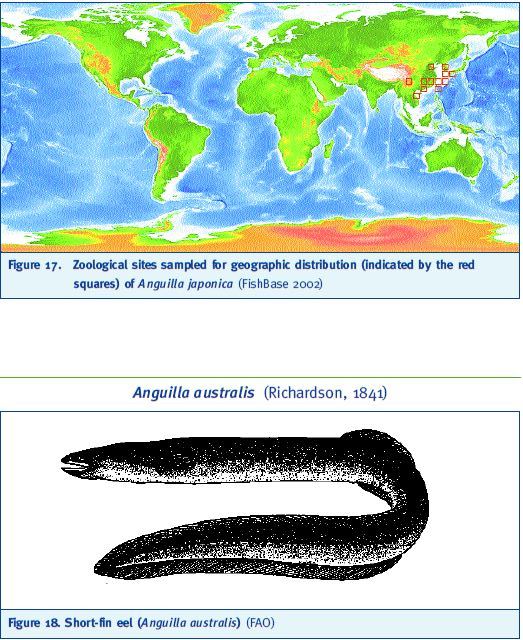
Figure 17. Zoological sites sampled for geographic distribution (indicated by the red squares) of Anguilla japonica (FishBase 2002)
Anguilla australis (Richardson, 1841)
Figure 18. Short-fin eel (Anguilla australis) (FAO)
Table 6. Characteristics of the Short-fin eel (Anguilla australis) (FishBase 2002, modified)
Common name Short-fin eel.
Size and age Maximum size of 130 cm TL (male/unsexed) and 106.5 cm TL (female); maximum weight is 7.5 kg; it can survive for a maximum of 32 years (Allen 1989).
Environment Demersal; freshwater; brackish; marine.
Climate and latitude Subtropical at 18°S-47°S.
Resilience Population doubling time is 4.5-14 years with low resilience.
Distribution Distributed in the South West Pacific: East coast of Australia and New Zealand, extending north to New Caledonia; cited in the West Indian Ocean.
Biology and ecology Feeds on fish, crustaceans, molluscs, worms, aquatic plants, and terrestrial and aquatic insects. Does not breed outside of its Pacific spawning ground. Migrates to the sea to breed (Armitage et al. 1994).
Importance Commercial fisheries and aquaculture; gamefish.
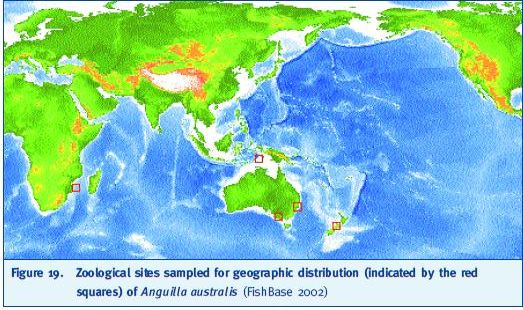
Figure 19. Zoological sites sampled for geographic distribution (indicated by the red squares) of Anguilla australis (FishBase 2002)